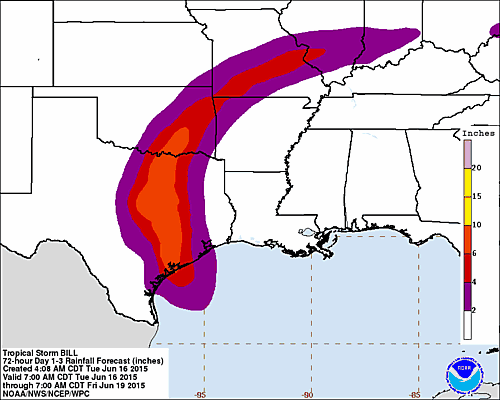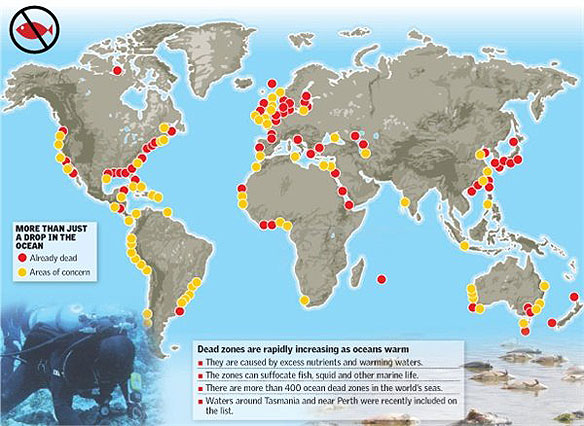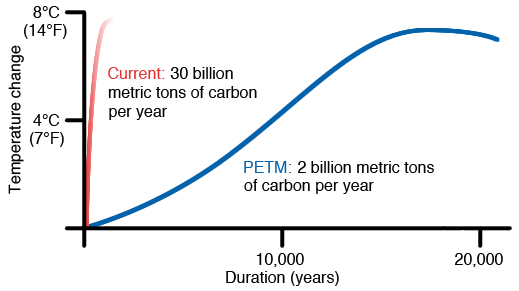Over the past week, various sources have leaked information passed on to them by the UN’s Intergovernmental Panel on Climate Change (IPCC). The reports highlighted stark consequences for continued failure by policy makers to act, providing a general view of rapidly approaching a terrible and very difficult to navigate global crisis.
Dancing on the Edge of a Global Food Crisis
The first weak link for human resiliency to climate change may well be in our ability to continue to supply food to over 7 billion people as weather and sea level rise takes down previously productive agricultural regions. And the leaked UN report hints at a currently stark global food situation in the face of a risk for rising crisis.
For the Mekong Delta, as with more and more agricultural regions around the world, by August of 2014, global warming was already a rampant crop killer.
The Vietnamese government this year made efforts to stem the effects of warming-driven sea level rise and saltwater invasion as 700,000 hectares of rice paddy farmland in one of the world’s most productive regions came under threat. But the efforts have not entirely prevented intrusion and many plants show the tell-tale yellowed leaves that result from salt water leeching into the low-lying freshwater fields that have, for so long, yielded a bounty of grain. Many farmers are now facing losses of up to 50% for crops that used to produce like clockwork year-in, year out. This year, the salt water has intruded as far as 40 to 50 kilometers inland, delivering a substantial blow to the region’s agriculture. But the potential effects, given even the IPCC’s conservative projections of sea level rise in the range of 29 to 82 more centimeters this century, are stark for this and other low-lying agricultural regions.

(UN FAO food price index since 1961. Note the spike since the mid 2000s coinciding with energy price increases and ramping crop destruction due to climate change. The first price spike during 2008 was primarily energy price related, but the second spike during 2011 coincided with a string of some of the worst spates of crop-destroying weather on record. Note that prices remained historically high following the 2011 spike, an indication that global agriculture was having difficulty meeting increased demand, despite the price signal. Image source: FAO.)
Around the world, tales from agricultural zones are much the same — ever-increasing challenges due to climate change driven droughts, floods, fires, spreading diseases, invasive species, and sea level rise. Since mid 2010, these added stresses have driven the United Nation’s FAO food price index — an indicator for global food security — above 200 for four years running. Historically, international insecurity and food-related unrest have sparked when prices hit and maintain above 208. And though the price of food has fallen somewhat from highs nearing 230 during 2011 to a range near 204 during 2014, the ongoing and worsening impacts of climate change mean that new and starker challenges to feeding the world’s 7 billion and growing population are just over the horizon.

(Instances of food riots from 2004 to late 2012 correlated with global food prices. Image source: ABC.)
These climate change related impacts are ongoing and, according to recent scientific reports, have resulted in a 3-5 percent loss of annual grain production for maize and wheat and could result in 10 percent total losses in grain production through the early 2020s. But even if agricultural difficulties are somehow delayed through the next decade, the UN report shows climate change eventually winning out by compounding damages that cause:
“slow down [of] economic growth, make poverty reduction more difficult, further erode food security, and prolong existing poverty traps and create new ones, the latter particularly in urban areas and emerging hot spots of hunger.”
Wide-ranging and Terrible Impacts
Of course, damages from climate change aren’t just limited to crops. More extreme weather, vicious heatwaves, rising seas, ocean acidification and anoxia, loss of glacial and ocean ice, rampant wildfires and other jarring impacts are likely to coincide as warming continues to spike higher.
At 0.85 degrees Celsius and 1.5 degrees Fahrenheit warming since 1880, we already see some rather radical impacts. But, according to IPCC, these impacts are likely to seem paltry if human business as usual emissions continue and hit the IPCC projected level of warming by 5.4 C or 9 F by the end of the 21st Century.
For illustration, IPCC provides the following impacts/risk graph:

(Projected risk related to a given level of warming according to IPCC via Bloomberg.)
As a risk-related graph, the analytical function is notably vague. The graph defines risks to unique systems (primarily natural ecosystems or human systems such as agriculture and tourism related to those systems), risks associated with extreme weather (which is self-explanatory), risks associated with distribution of impacts (which generally defines how widespread climate impacts will become), risks associated with global aggregate impacts (this attempts to define the level of net positive or net negative impact, with some positive impacts resulting in an almost neutral net impact early on but overall and increasingly severe net negative aggregate impacts going forward), and risks associated with singular large-scale events (related to catastrophic weather or Earth changes such as glacial outburst floods, methane release, slope collapse and other unforeseen catastrophic, large-scale instances).
For +0.85 C warming above 1880s levels, we can add an imaginary line at +0.25 C above the 1986 to 2005 level. There we find current changes that are now visible and ongoing and that, to us, seem pretty substantial. Along that line, we see risks to some threatened systems from climate change (ramping damage to reefs, agriculture, rainforests etc), a moderate risk of extreme weather events outside the 20th Century norm (and we see these with increasing frequency), we are edging into increasing risks of disruption in some regions (as we’ve seen in Syria, the US Southwest and a shot-gun of other areas), we are edging into a zone where most people are starting to see impacts (though these are still comparatively minor for many, but increasingly bad for a growing minority), and we are at low but rising risk of catastrophic events (major glacial outburst floods, methane release, continent spanning megastorms etc).
And given this context, we can see how much worse things will be with just another 0.25, 0.75, or 1.5 C of warming. By the end of this century, under business as usual, we are at the top of the risk graph and would be witnessing events that many of us would now consider both strange and terrifying.
IPCC researchers add the following chilling and entirely apt caveat (Bloomberg):
“Many aspects of climate change and associated impacts will continue for centuries, even if anthropogenic emissions of greenhouse gases cease,” the researchers said. “The risk of abrupt and irreversible change increases as the magnitude of the warming increases.”
To this point, I would like to add that some changes are now irreversible, but the worst impacts are not, as yet, unavoidable.
The Terrifying Rate of Human Emission
IPCC now recognizes that human greenhouse gas emissions are at or near worst case levels. Current global volume of all human greenhouse gas emissions is now likely in excess of 50 gigatons of CO2 equivalent (CO2e) each year. As of the latest IPCC assessment, the emission stood at 49 gigatons CO2e for greenhouse gasses each year by 2010 (more than 13 gigatons carbon). This rate of emission, if continued and/or increased through the end of this century, is enough to trigger Permian Extinction event type conditions over the course of just three centuries or less (the Permian Extinction took tens of thousands of years to elapse) a shock that is unprecedented on geological time-scales.

(Global greenhouse gas emissions from 1970 through 2010. Included are human emissions from CO2 through fossil fuel burning, CO2 through land use, Methane emissions, N2O emissions, and fluoride gas emissions. Image source IPCC via Bloomberg.)
This immense volume of emission is probably more than 6-10 times faster than at any period of the geological record. Its vast and violent outburst is worse than any of the great flood basalts of Earth’s long history. And its pace of out-gassing will rapidly overwhelm any of Earth’s carbon sinks, likely turning many of these into sources. The human greenhouse gas emission is, therefore, likely on track to be the worst greenhouse gas disaster the Earth system has ever experienced.
Rapid Mitigation is the Only Moral Option
To this point, IPCC recommends rapid mitigation to prevent the worst possible consequences.
“Risks from mitigation can be substantial, but they do not involve the same possibility of severe, widespread, and irreversible impacts as risks from climate change, increasing the benefits from near-term mitigation action,” the authors wrote.
IPCC finds that the cost of mitigation is low so long as policies aim to rapidly reduce energy consumption, rapidly affix existing carbon emitting infrastructure with carbon capture and storage, leave new and unconventional fossil fuel sources in the ground while allowing existing sources to go into decline or be replaced outright by alternative energy, keep current nuclear capacity running until the end of its life expectancy, and provide all replacements and new additions for energy generation through various renewable energy sources (my personal opinion about the carbon capture policy position is that it creates moral hazard by giving the fossil fuel interests wiggle room, but that discussion is for another post).
IPCC model runs show a stark difference between business as usual fossil fuel emission based warming and warming by end century under rapid mitigation:

(Approximate 1.9 C warming by 2100 under rapid mitigation vs 5.4 C warming under business as usual. Note that potential substantial Arctic and marine carbon store feedbacks are likely not fully taken into account and may require additional mitigation to alleviate. Source: IPCC via ThinkProgress.)
The approximate 3.5 C difference between the rapid mitigation scenario and the business as usual scenario is a glaring contrast between a world in which humans can cope with and reduce the long term impacts of difficult to deal with climate change and a world in which climate change essentially wrecks all future prospects. Between these two choices, there is only one moral and, indeed, sane option.
Overall, the most recent IPCC report is likely to receive broad criticism from climate change deniers for its more direct language. And this is probably a good sign that it is on the right track. In my view, however, the report is still cautious and leaves out a number of key risks, including significant amplifying feedbacks from Arctic carbon stores and other carbon stores, or simply deals with them by implication without further analysis (such as through the use of the term ‘large-scale singular events’ in the graph above). So, in some ways, the report hides actual risks behind obtuse language and dense scientific terminology.
Given the current behavior and mindset of policy-makers, an even more direct approach may well be necessary. That said, the current IPCC report, as alluded to by these leaks, appears to be a far more impactful summation than its previous iterations. Given the very narrow window in which we have to prevent the most severe future harm, such a shift is appreciated and highly appropriate.
Links:
Climate Scientists Spell Out Stark Danger and Immorality of Inaction in New Leaked Report
Climate Trends and Global Crop Production Since 1980
Irreversible Damage From Climate Change
UN Draft Report Lists Unchecked Emissions Risks
Climate Change Impacts to Mekong Delta
Rising Sea Level Means Trouble For Vietnam’s Rice Farmers
FAO World Food Price Index
Hat Tip to TDGS





















































